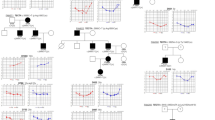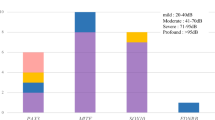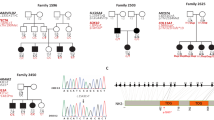Abstract
Non-syndromic hearing loss (NSHL) is characterized by a vast genetic heterogeneity; some syndromic forms as Usher syndrome (USH) have onset as isolated deafness and then evolve later in life. We developed an NGS targeted gene-panel containing 59 genes and a customized bioinformatic pipeline for the analysis of DNA samples from clinically highly selected subjects with sensorineural hearing loss, previously resulted negative for GJB2 mutations/GJB6 deletions. Among the 217 tested subjects, 24 (11.1%) were found to carry mutations in genes involved both in NSHL and USH. For 6 out of 24 patients a diagnosis of USH was performed. Eleven subjects out of 24 had hearing loss without vestibular or ocular dysfunction and, due to their young age, it was not possible to establish whether their phenotype could be NSHL or USH. Seven subjects were diagnosed with NSHL, due to their age and phenotype. A total of 41 likely pathogenic/pathogenic mutations were identified, among which 17 novel ones. We report a high frequency of mutations in genes involved both in NSHL and in USH in a cohort of individuals tested for seemingly isolated deafness. Our data also highlight a wider than expected phenotypic variability in the USH phenotype.
This is a preview of subscription content, access via your institution
Access options
Subscribe to this journal
Receive 12 print issues and online access
$259.00 per year
only $21.58 per issue
Buy this article
- Purchase on Springer Link
- Instant access to full article PDF
Prices may be subject to local taxes which are calculated during checkout



Similar content being viewed by others
References
Morton CC, Nance WE. Newborn hearing screening-a silent revolution. N Engl J Med. 2006;354:2151–64.
Koffler T, Ushakov K, Avraham KB. Genetics of hearing loss: syndromic. Otolaryngol Clin North Am. 2015 ;48:1041–61.
Parker M, Bitner-Glindzicz M. Genetic investigations in childhood deafness. Arch Dis Child. 2014;0:1–8. http://www.ncbi.nlm.nih.gov/pubmed/25324569
Kimberling WJ, Hildebrand MS, Shearer AE, Jensen ML, Halder JA, Trzupek K, et al. Frequency of Usher syndrome in two pediatric populations: Implications for genetic screening of deaf and hard of hearing children. Genet Med. 2010;12:512–6.
Jouret G, Poirsier C, Spodenkiewicz M, Jaquin C, Gouy E, Arndt C, et al. Genetics of Usher syndrome: new insights from a meta-analysis. Otol Neurotol. 2019;40:121–9.
Dad S, Rendtorff ND, Tranebjærg L, Grønskov K, Karstensen HG, Brox V, et al. Usher syndrome in Denmark: mutation spectrum and some clinical observations. Mol Genet Genom Med. 2016;4:527–39.
Mathur P, Yang J. Usher syndrome: hearing loss, retinal degeneration and associated abnormalities. Biochim Biophys Acta Mol Basis Dis. 2015;1852:406–20.
del Castillo FJ, Rodriguez-Ballesteros M, Alvarez A, Hutchin T, Leonardi E, de Oliveira CA, et al. A novel deletion involving the connexin-30 gene, del(GJB6-d13s1854), found in trans with mutations in the GJB2 gene (connexin-26) in subjects with DFNB1 non-syndromic hearing impairment. J Med Genet. 2005;42:588–94.
Kumar P, Henikoff S, Ng PC. Predicting the effects of coding non-synonymous variants on protein function using the SIFT algorithm. Nat Protoc. 2009;4:1073–81.
Adzhubei IA, Schmidt S, Peshkin L, Ramensky VE, Gerasimova A, Bork P, et al. A method and server for predicting damaging missense mutations. Nat Methods. 2010;7:248–9.
Schwarz JM, Rodelsperger C, Schuelke M, Seelow D. MutationTaster evaluates disease-causing potential of sequence alterations. Nat Methods. 2010;7:575–6.
Reva B, Antipin Y, Sander C. Predicting the functional impact of protein mutations: application to cancer genomics. Nucleic Acids Res. 2011;39:e118.
Chun S, Fay JC. Identification of deleterious mutations within three human genomes. Genome Res. 2009;19:1553–61.
Shihab HA, Gough J, Cooper DN, Day INM, Gaunt TR. Predicting the functional consequences of cancer-associated amino acid substitutions. Bioinformatics. 2013;29:1504–10.
Kircher M, Witten DM, Jain P, O’Roak BJ, Cooper GM, Shendure J. A general framework for estimating the relative pathogenicity of human genetic variants. Nat Genet. 2014;46:310–5.
Ioannidis NM, Rothstein JH, Pejaver V, Middha S, McDonnell SK, Baheti S, et al. REVEL: an ensemble method for predicting the pathogenicity of rare missense variants. Am J Hum Genet. 2016;99:877–85.
Pertea M, Pertea GM, Salzberg SL. Detection of lineage-specific evolutionary changes among primate species. BMC Bioinform. 2011;12:274. http://bmcbioinformatics.biomedcentral.com/articles/https://doi.org/10.1186/1471-2105-12-274
Davydov EV, Goode DL, Sirota M, Cooper GM, Sidow A, Batzoglou S. Identifying a high fraction of the human genome to be under selective constraint using GERP++. PLoS Comput Biol. 2010;6:e1001025.
Garber M, Guttman M, Clamp M, Zody MC, Friedman N, Xie X. Identifying novel constrained elements by exploiting biased substitution patterns. Bioinformatics. 2009;25:54–62.
Jehl P, Manguy J, Shields DC, Higgins DG, Davey NE. ProViz-a web-based visualization tool to investigate the functional and evolutionary features of protein sequences. Nucleic Acids Res. 2016;44:W11–5.
Desmet F-O, Hamroun D, Lalande M, Collod-Beroud G, Claustres M, Beroud C. Human splicing finder: an online bioinformatics tool to predict splicing signals. Nucleic Acids Res. 2009;37:e67.
Richards S, Aziz N, Bale S, Bick D, Das S, Gastier-Foster J, et al. Standards and guidelines for the interpretation of sequence variants: a joint consensus recommendation of the American College of Medical Genetics and Genomics and the Association for Molecular Pathology. Genet Med. 2015;17:405–24.
Li Q, Wang K. InterVar: Clinical Interpretation of Genetic Variants by the 2015 ACMG-AMP Guidelines. Am J Hum Genet. 2017;100:267–80. http://linkinghub.elsevier.com/retrieve/pii/S0002929717300046
den Dunnen JT, Dalgleish R, Maglott DR, Hart RK, Greenblatt MS, McGowan-Jordan J, et al. HGVS recommendations for the description of sequence variants. Hum Mutat. 2016;37:564–9.
Oza AM, DiStefano MT, Hemphill SE, Cushman BJ, Grant AR, Siegert RK, et al. Expert specification of the ACMG/AMP variant interpretation guidelines for genetic hearing loss. Hum Mutat. 2018;39:1593–613.
Aspromonte MC, Bellini M, Gasparini A, Carraro M, Carlet O, Negrin S, et al. Characterization of intellectual disability and Autism comorbidity through gene panel sequencing. Hum Mutat. 2019;1–32.
Bork JM, Peters LM, Riazuddin S, Ahmed ZM, Li XC, Griffith AJ, et al. Usher syndrome 1D and nonsyndromic autosomal recessive deafness DFNB12 are caused by allelic mutations of the novel cadherin-like gene CDH23. Am J Hum Genet. 2001;68:26–37.
Schultz JM, Bhatti R, Madeo AC, Turriff A, Muskett JA, Zalewski CK, et al. Allelic hierarchy of CDH23 mutations causing non-syndromic deafness DFNB12 or Usher syndrome USH1D in compound heterozygotes. J Med Genet. 2011;48:767–75.
Aller E, Jaijo T, Beneyto M, Nájera C, Morera C, Pérez-Garrigues H, et al. Screening of the USH1G gene among Spanish patients with usher syndrome. Lack of mutations and evidence of a minor role in the pathogenesis of the syndrome. Ophthalmic Genet. 2007;28:151–5.
Booth KT, Kahrizi K, Babanejad M, Daghagh H, Bademci G, Arzhangi S, et al. Variants in CIB2 cause DFNB48 and not USH1J. Clin Genet. 2018;93:812–21.
Acknowledgements
The authors wish to thank the family members for their active participation in the study.
Author information
Authors and Affiliations
Corresponding author
Ethics declarations
Conflict of interest
The authors declare that they have no conflict of interest.
Additional information
Publisher’s note Springer Nature remains neutral with regard to jurisdictional claims in published maps and institutional affiliations.
Supplementary information
Rights and permissions
About this article
Cite this article
Cesca, F., Bettella, E., Polli, R. et al. Frequency of Usher gene mutations in non-syndromic hearing loss: higher variability of the Usher phenotype. J Hum Genet 65, 855–864 (2020). https://doi.org/10.1038/s10038-020-0783-1
Received:
Revised:
Accepted:
Published:
Issue Date:
DOI: https://doi.org/10.1038/s10038-020-0783-1
This article is cited by
-
Spectrum of variants associated with inherited retinal dystrophies in Northeast Mexico
BMC Ophthalmology (2024)
-
Vestibulo-ocular reflex dynamics with head-impulses discriminates Usher patients type 1 and 2
Scientific Reports (2024)
-
Genetic etiology of non-syndromic hearing loss in Europe
Human Genetics (2022)



